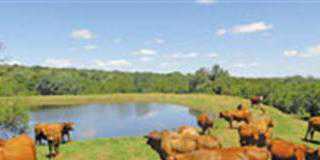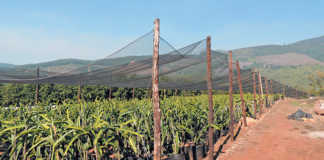
Photo: Brian van Wilgen
An experiment on the use of high-intensity fires to control bush encroachment in South Africa’s Kruger National Park (KNP) has revealed that these fires did not result in a meaningful long-term reversal of the problem.
In mid-February 2023, the results of this large-scale, decade-long investigation were published in the Journal of Applied Ecology in an article titled ‘High-intensity fires may have limited medium-term effectiveness for reversing woody plant encroachment in an African savanna’.
Prof Brian van Wilgen, emeritus professor of invasion biology at Stellenbosch University (SU) and one of the co-authors of the article, says most studies that advocate the use of high-intensity fires in the fight against bush encroachment are based on short-term observations.
“I think [ours] is the first study to assess the effectiveness of this management practice over a decade,” he adds.
Causes are unclear
Bush or woody encroachment, a natural process involving the increase in density of smaller trees and shrubs, is taking place in savannahs around the world.
This is concerning, since increased woody cover results in less grass being available for animals to graze or use as a habitat.
Although the true causes are complex and not that clear, it is generally accepted that a reduction in the frequency and intensity of fires, coupled with an increase in atmospheric carbon dioxide (CO2), may be to blame.
In 2010 and again in 2013, adjacent sites in the southern parts of the KNP, covering thousands of hectares, were burnt using low-, medium- and high-intensity fires.
The objective was to examine whether high-intensity fires can be used to reverse bush encroachment.
At the time of the first burn application, officials at KNP had to deal with substantial negative publicity after some of the animals were mortally injured.
A study reporting the effects on woody plant cover one year after the completion of the second set of experimental fires showed that woody plant cover did indeed decline significantly over this short period.
However, the initial study cautioned that the long-term efficacy of these high-intensity fires still needed to be confirmed.
In 2020, using a combination of ground surveys and remote sensing data collection, scientists from South African National Parks (SANParks), Harvard University, and the Centre for Invasion Biology at SU compared the 2010 data with their 2020 observations.
Despite the fact that the initial results were encouraging, they found that the reduced woody plant cover wasn’t maintained after 10 years.
Even though there were large differences in the fire-treatment sites one year after the experimental fires, these differences had disappeared within a decade. This strongly suggests that fires of different intensities do not have long-term effects on bush encroachment.
Even more concerning is the trend of tall-tree loss in KNP. Over the past decade, trees taller than 10m declined by about 65% across all the experimental sites, regardless of the fire treatment.
According to Tercia Strydom, SANParks scientist and first author on the article, this was the result of a combination of elephant and fire damage. “Tall trees are normally capable of withstanding frequent savannah fires due to their thick bark. But when elephants debark trees (because they eat the bark), the inner wood of the trees is left exposed. When this inner wood dries out, it burns and smoulders within the trees until the trees eventually succumb [to the fire],” she explains.
Lessons learnt
According to Van Wilgen, the study shows the value of long-term monitoring to establish the real outcome of fire treatments, and not to jump to conclusions: “It also shows how complex things can be, and that there is no easy fix for bush encroachment.”
Dr Izak Smit, senior scientist at SANParks and another co-author of the paper, says KNP continues to follow a strategic adaptive management approach in which local context is paramount.
“The best available knowledge needs to be gathered from the literature and, based on that, a careful evaluation must inform what management action you consider appropriate to implement in your area of interest. The outcomes of this action should be carefully monitored to see whether or not you actually obtain the anticipated outcomes,” says Smit.
“This way, ecology reveals its complexity and nuances in different contexts and allows us to fine-tune the way we manage protected areas, learning as we continue to manage in the face of uncertainty,” he adds.
The experts warn that, on a global scale, intercontinental and even intracontinental generalisations regarding the most appropriate management actions for bush encroachment remain elusive.
According to Strydom, this case study may not even be representative of other parts of Southern Africa due to differences in elephant population density, soil type and rainfall, among a plethora of other factors.
The way forward
KNP has a long history of scientific research, and Smit says they are now exploring the potential of early wet- or early dry-season fires to address bush encroachment as an alternative to high-intensity fires.
“When woody species are dormant during the dry season, they move a lot of their resources to their roots while the top parts are ‘resting’. If a fire consumes the above-ground parts during this period, the plant still has a lot of resources stored below the ground from which it can resprout when conditions become favourable,” explains Smit.
“However, if the plant is in leaf and a fire burns the above-ground parts, it is expected that the damage is more costly to the plant, which is what we want when it comes to bush encroachment.
“Therefore, the trick is to try to burn when there is sufficient dry grass to carry fires of reasonable intensity, while at the same time the bush species are in a more vulnerable leaf-on phase.
“Spring sometimes provides this window of opportunity, where the grass is still dry enough to burn and the woody species are already in leaf and thus more vulnerable to fire damage,” he adds.
In the end, says Smit, one needs to understand both the local (for example, fire and grazing) and global drivers of change (such as elevated atmospheric CO2), and their interactions with each other, in order to tease out if and how different management actions (or inactions) may improve the situation, or even make it worse.
Email Prof Brian van Wilgen at [email protected].










